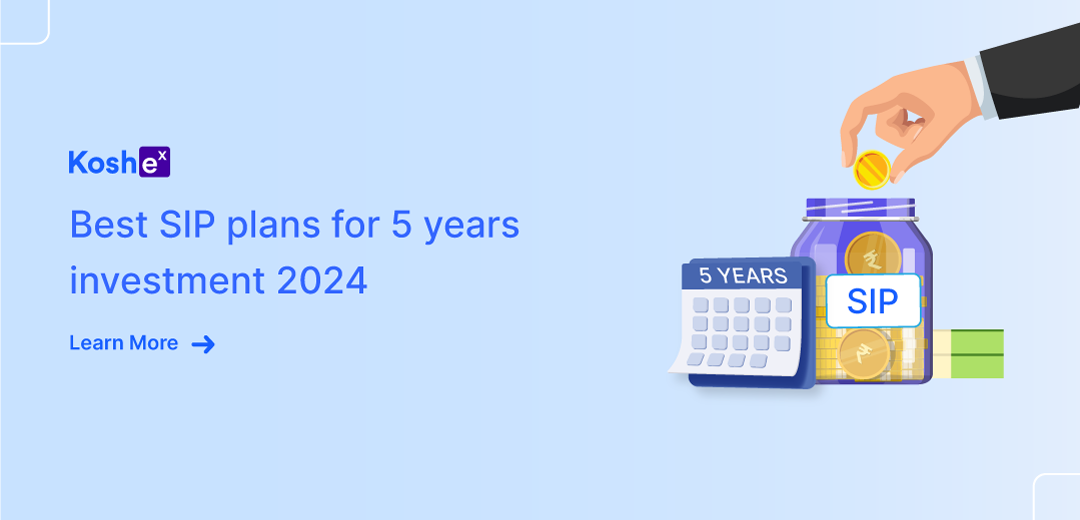Investing money wisely is a crucial aspect of financial planning. With so many options available, investors are always on their toes exploring different avenues and, in some cases, also fall into dilemmas. However, one avenue that never failed to garner investor’s attention is the Systematic Investment Plan (SIP). SIPs offer a disciplined approach to investing, making them an excellent choice for both beginners and experienced investors.
But what exactly is SIP and why is it so popular among the investors? And what are the best SIP plans to invest in? Let’s explore the best SIP plans for a 5-year investment horizon in 2024, the advantages of SIP over lump sum investments, and essential considerations for SIP investing with Koshex.
What is a Systematic Investment Plan?
Systematic Investment Plan (SIP) is not a separate investment avenue but a method of investing in mutual funds in a regular and disciplined manner. It involves investing a fixed amount of money at regular intervals, usually monthly in the chosen mutual fund scheme. SIPs provide investors with an opportunity to enter the financial markets with a small sum of money which is then systematically invested over time. This strategy reduces the impact of market volatility on investments and allows investors to benefit from rupee cost averaging.
How Is SIP Better Than Lump Sum Investment?
Lumpsum investment means investing a lump sum amount in the mutual fund scheme at a single point in time as against regular investing. The best SIP plans offer several advantages over lump sum investments including but not limited to the following:
- Risk Mitigation: SIPs spread your investments over time, reducing the risk of investing a large sum at an unfavorable market moment.
- Rupee Cost Averaging: Market volatility becomes more of a friend than an enemy to your investment. SIP investments allow you to benefit from market volatility by buying more units when prices are low. Further, when prices increase, you may get allotted a lower number of units but your overall portfolio value increases. This averages your cost of investment and hence, is known as rupee cost averaging.
- Disciplined Saving: As you need to invest the predetermined amount each month, SIPs encourage regular and disciplined saving, promoting a habit of long-term wealth creation. It eliminates the need to time the market.
- Smaller Initial Investment: SIPs allow investors to start with a small initial investment, making it accessible to a wide range of investors. You can start investing through SIP with as low as Rs. 500.
- Flexibility: You can increase, decrease, or pause your SIP investments as per your financial situation, offering flexibility and control over your investments.
- Power of Compounding: SIPs benefit from the power of compounding over the long term as returns generated are reinvested into the assets unlocking exponential growth over time.
Top SIP Mutual Funds to Invest in 2024
There’s no doubt SIPs offer several advantages and are a must-have in your investment portfolio. But which ones are ideal for you? As per the data from MoneyControl on 24 September 2024, we have compiled a list of the 5 best SIP plans you can consider based on the historical returns generated. These funds have a track record of consistent performance and are managed by reputed asset management companies (AMCs):
1) Nippon India Small Cap Fund – Growth
This fund is the small-cap fund by Nippon India. It invests 58.39% of its funds in small-cap stocks. The total fund size is Rs. 36,539.55 crores and has an expense ratio of 1.55%. The fund has been in existence for 10+ years and the annualized SIP returns over 10 years is 24.69%.
2) Quant Small Cap Fund – Growth
This fund is the small-cap fund by Quant. It invests 48.97% of its funds in small-cap stocks. The total fund size is Rs. 8075.14 crores and has an expense ratio of 1.78%. The fund has been in existence for 10+ years and the annualized SIP returns over 10 years are 23%.
3) HDFC Mid-Cap Opportunities Fund – Growth
This fund is the mid-cap fund by HDFC. It invests 55.42% of its fund in mid-cap stocks. The total fund size is Rs. 47,236.04 crores and has an expense ratio of 1.53%. The fund has been in existence for 10+ years and the annualised SIP returns over 10 years are 19.42%. annualized
4) Nippon India Multicap Fund – Growth
This fund is the multicap fund by Nippon. It spreads its funds across all the 3 caps uniformly. The total fund size is Rs. 20,192.22 crores and has an expense ratio of 1.69%. The fund has been in existence for 10+ years and the annualized SIP returns over 10 years is 17.17%.
5) Bank of India Manufacturing & Infrastructure Fund – Growth
This fund is the sectoral/thematic fund by the Bank of India. It spreads its funds across all 3 caps in a predetermined ratio based on performance with a focus on the manufacturing and infrastructure sectors. The total fund size is Rs. 127.87 crores and has an expense ratio of 2.46%. The fund has been in existence for 10+ years and the annualized SIP returns over 10 years is 17.69%.
Things to Keep in Mind While Investing in SIP
While we saw the best SIP plans to invest 2024, before you start investing in SIPs, you should also consider the following factors:
- Risk Tolerance: Assess your risk tolerance and choose SIP plans that align with your risk profile.
- Investment Goals: Define your financial goals and purpose of investment. It may be buying a house, funding education, or retirement planning. Your goals will influence the choice of the best SIP plans to invest in.
- Diversification: Diversify your SIP portfolio across different asset classes to minimize risk while maximizing returns.
- Fund Performance: Research the historical performance of SIP funds considering both short-term and long-term returns. This will help you make an informed choice.
- Fund Manager Expertise: Evaluate the expertise and track record of the fund manager managing the SIP fund.
- Expense Ratio: Look for SIP funds with a lower expense ratio as this directly impacts your overall returns.
Summing Up
Systematic Investment Plans (SIPs) are an excellent way to start investing in the financial markets. It offers you a disciplined approach to investing while ensuring risk mitigation and long-term wealth creation. When selecting the best SIP plans to invest for a 5-year investment horizon in 2024, you should consider your financial goals, risk tolerance, and the performance track record of the funds. But which platform is ideal for investing?
Koshex has been the investor’s choice when it comes to mutual fund investment. It ensures that you never run out of choice with over 5000+ different funds to invest in across different classes and types. With a user-friendly and easy-to-navigate interface, it gives you a seamless investing experience. With knowledge and proper guidance, you too can explore the top SIP mutual funds to invest in 2024. Sign up now with Koshex!
Frequently Asked Questions
Q: Can I invest in SIPs with a small amount of money?
A: Yes. SIPs allow you to start investing with a small amount, as low as Rs. 500 per month, making them accessible to a wide range of investors.
Q: Can I change my SIP amount after starting an SIP?
A: Yes. SIPs are highly flexible investment avenues and you can increase, decrease, or even pause your SIP investments based on your financial situation and goals.
Q: Are SIP returns guaranteed?
A: No investment avenue provides a 100% guarantee, including the best SIP plans. SIP returns are subject to market fluctuations. However, they offer a disciplined approach to investing that can help mitigate risk.
Q: What is the lock-in period for SIP investments?
A: SIP investments do not have a lock-in period. You can redeem your units at any time, subject to the fund’s terms and conditions. However, if you invest in ELSS or tax-saver funds, they come with a lock-in period of 3 years due to inherent tax benefits.









Leave a Comment